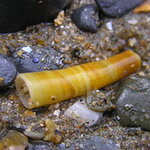Paleontology

The priest of Vigevano's Duomo must have been startled to realize that by far the most faithful presence at mass, ever since the altar was built, is not nonna Pina but a real dinosaur -a glaring testimony of the falsity of catholic-diffused pseudoscience and of the true origin of life on Earth. The red circle in the picture on the right shows the location of the marble slab in the altar.
It is only thanks to the good eye of a paleontologist who happened to walk by the altar, Andrea Tintori, that the piece of marble supporting the columns has risen to better fame. Its surface (see right)…
New dinosaurs in a long-forgotten world and you've never heard of it? Don't be alarmed, the "lost continent" of Laramidia was formed when a shallow sea flooded the central region of North America, isolating the eastern and western portions of the continent for millions of years during the Late Cretaceous Period. It was a swampy, subtropical setting - in Utah.
But it wasn't the only thing lost. Two new species of horned dinosaurs have been found in Grand Staircase-Escalante National Monument in southern Utah.
Ancient western interior seaway that divided the "lost…
Paleontologists have released details about Concavenator corcovatus, a carnivorous humpbacked dinosaur discovered in Spain - and it oddly had both feathers and scales.
Concavenator corcovatus was a theropod dinosaur that lived during the Cretaceous period, about 130 million years ago. Concavenator corcovatus translates to 'hump-backed predator from Cuenca', where it was discovered.
It's odd feature set includes tall vertebrae in front of the hips which formed what appear to be a hump. The Spanish scientists who discovered it, paleontologists José Luis Sanz, Francisco…

The fossil exposures of the Lincoln Creek Formation, southern Olympic Peninsula, near the town of Porter, Washington consist of tuffaceous siltstone and sandstone with concretionary beds throughout. They are slightly older than originally thought, coming in around 37 million-years, straddling the Eocene-Oligocene border. The site has produced several dozen different species of molluscs, including the elusive tusk shell, and is well known for crabs.
Here a wee modern tusk shell or scaphopod sits in the sand. The whitish aragonitic shells of scaphopods are…

Cache Creek is the gateway to B.C.'s Cariboo Country, sporting big, open fields, cowboys and horses. It is also the stepping off point for field trips to the Eocene fossil beds at McAbee and Kamloops Lake where fish, insects and plant fossils abound.
While the site is now an arid hillside topped with finger-like hoodoos, some 51 million years ago it was a flourishing lake. As fish and other inhabitants died, their remains settled to the bottom and were preserved in the fine-grained clay, ash and silt that would one day become shale. McAbee, named for the nearby village of McAbee on the…
Princeton scientists say they may have discovered the oldest fossils of animal bodies; sponge-like creatures that were living in ocean reefs 650 million years ago. The shelly fossils, found beneath a 635 million-year-old glacial deposit in South Australia, would represent the earliest evidence of animal body forms in the current fossil record by at least 70 million years.
The oldest known fossils of hard-bodied animals were from two reef-dwelling organisms that lived about 550 million years ago; Namacalathus, discovered in 2000 by John Grotzinger's group at the Massachusetts Institute of…

The Solenodon, 76-million-year-old badass of the natural world, must be saved
So says Lucy Jones, the Telegraph's Culture Blogs Editor, who normally writes about popular culture and aesthetics, specialising in music, film and fashion. But she puts it much better than I could.
Researchers have unearthed a new species of horned dinosaur in Mexico with larger horns that any other species – up to 4 feet long. The finding has given scientists fresh insights into the ancient history of western North America, according to a research team led by paleontologists from the Utah Museum of Natural History at the University of Utah.
"We know very little about the dinosaurs of Mexico, and this find increases immeasurably our knowledge of the dinosaurs living in Mexico during the Late Cretaceous," said Mark Loewen, a paleontologist with the Utah Museum of Natural History…

Finally, there is at least some controversy about Ardipithecus ramidus - 'Ardi'.
Ardi was the missing link that was bigger than a meteor hitting the Earth or whatever, right? Nope, that was Darwinius, also called Ida (see Science by PR Blitz). This one got nowhere near the press because they didn't have a book and TV show about it before the science was even revealed. Ardi discoverers also don't claim it is anything more than what it is - a creature phylogenetically descended from whatever humans and chimps are descended from - but they made one claim about its…
Scientists say ancient fossils unearthed in the Sahara desert belong to a new type of pterosaur (giant flying reptile or pterodactyl) that existed about 95 million years ago. According to the findings published PLoS ONE, the researchers consider the newly identified pterosaur to be the earliest example of its kind.
The scientists have named the new pterosaur Alanqa saharicafrom the Arabic word 'Al Anqa' meaning Phoenix, a mythological flying creature that dies in a fire and is reborn from the ashes of that fire.
Unearthed in three separate pieces, the jaw bone has a total length of 344mm (13.…